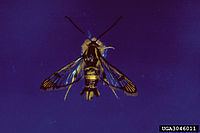Rank Species | Genus Synanthedon | |
 | ||
Similar Synanthedon, Synanthedon pictipes, Synanthedon exitiosa, Synanthedon acerni, Synanthedon myopaeformis | ||
Synanthedon scitula, the dogwood borer or pecan borer, is a major pest of many plants including the dogwood and pecan. It is an extremely notorious pest due to its severity and its widespread geographical distribution.
Contents
Eggs
Synanthedon scitula eggs are a light chestnut brown color and are 0.4 to 0.6 millimeters across. They are marked with a hexagonal pattern of lines. The eggs are laid singly by the mother and take 8–9 days to hatch.
Larvae
Synanthedon scitula larvae are cream colored with a red head. They pass through six instars ranging in length from 1 millimeter to 15 millimeters or more at the last instar. Soon after hatching they burrow into the burrknot tissue or areas around bark scales. As the dogwood borer larvae feed red frass is pushed to the surface. It collects and is pushed to the surface and held together by silk. Larvae overwinter in their feeding tunnel, and resume eating whenever the temperature exceeds 45 to 50 degrees Fahrenheit, or 7 to 10 degrees Celsius.
Pupae
The larvae pupate in their feeding tunnel in a tough silken cocoon covered with bits of frass. The length of pupation varies from 8 to 20 days, depending on the temperature and other factors. Before its emergence, the pupa pushes out of its cocoon and emerges on the soft burrknot tissue. The amber-colored pupal case often remains on the burrknot after the adult emerges.
Adults
The average adult has a wing span of 18 to 22 millimeters. Both the fore and hind wings are mostly clear, and the thorax and the abdomen are navy blue or black with yellow markings. Female dogwood borer's 4th abdominal segment is entirely yellow, while the male's is black with a narrow yellow ring. In the Northeast, adult emergence begins in early June and continues into early September, peaking in mid July. The adult's emergence begins earlier further south.
Control
The most recommended method of control is to avoid the development of the burrknot. However, rootstocks without the tendency to make a burrknot have not yet been developed. Several types of fungi and parasitoids have been reported to attack the Pecan Borer but have not been used yet effectively against the pest.
Damage and diet
The dogwood borer does damage to various trees and shrubs, including apple, bayberry, black cherry, blueberry, beech, birch, chestnut, dogwood, elm, hazel, hickory, mountain-ash, oak, pecan, pine and willow trees. There are three main feeding types that the pecan borer has that results in various degrees of damage.
